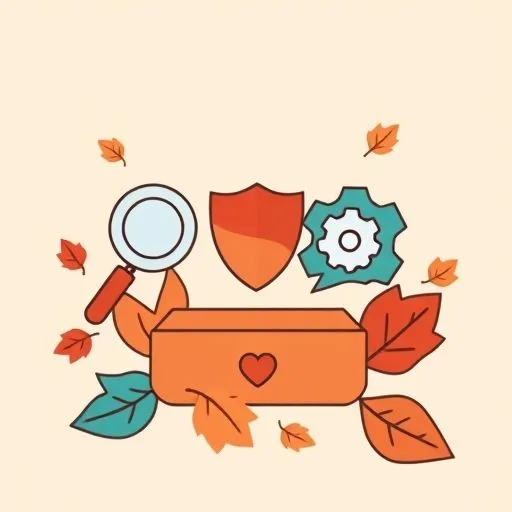
Imagine the house is finally quiet. The day’s beautiful chaos has settled, and you’re curled up on the sofa, perhaps scrolling through your phone, unwinding after another full day.
I’m just watching you, thinking about our day, and then something from the news bubbles up – a story about an AI voice scam, someone’s parent almost fooled by a voice that sounded exactly like their child.
It makes you pause, doesn’t it?
That quiet moment, a small ripple of unease. This rush of AI, it’s everywhere now, woven into so many parts of our lives, and sometimes it feels like we’re just trying to keep up, to understand its language.
But it’s not about fear, is it? It’s about knowing, about understanding how these shifts gently touch our lives, our family, and the quiet rhythm of our home. It’s about finding that steady strength to navigate it all, together.
Because even as the world speeds up, the heart of our home, our human connection, that’s what truly matters.
And there are simple, everyday ways we can keep that protected, anchoring us in our shared journey, even as technology evolves around us.
The Breakneck AI Journey: What’s Really Happening Around Us?

Remember when AI felt like something out of a sci-fi movie? Maybe a robot vacuum cleaner, or those slightly clunky voice assistants that would sometimes suggest decorating our living room with… flying cars? (Always good for a laugh, those early glitches, a gentle reminder to keep our common sense firmly on the ground!)
But look around now – what once felt futuristic is now helping us manage our daily routines.
Now, it’s in everything. From helping you sort through emails to personalizing our streaming suggestions, or even that brilliant app that helps the children with their homework – it’s seamlessly woven into our daily rhythm.
It’s moved from basic tasks to understanding complex ideas, almost overnight. And often, we don’t even realize it’s AI behind the scenes, quietly shaping our experiences.
It’s not about being overwhelmed, love. It’s just about recognizing that this incredible wave of change is here, and understanding its presence is the first, quiet step towards feeling grounded. It helps us see the forest, not just the trees, in our shared world, allowing us to think about how we’re navigating AI for families in this new landscape.
Spotting the Silent Threats: Real Risks We All Face

It’s easy to think these ‘tech threats’ are for someone else, isn’t it? Like those voice cloning scams we talked about, or even the subtle biases that can creep into AI tools used in job applications, quietly affecting someone’s chances.
But the truth is, these currents ripple through everyone’s world, sometimes in ways we don’t immediately see. We have that incredible intuition and knack for noticing the small details; we’re already so good at sensing when something feels ‘off.’ It’s about extending that same thoughtful discernment to the digital world.
A quick double-check, a moment to question if that email or message is truly from who it claims to be, or if that viral video is actually real. These small acts of verification aren’t about being paranoid; they’re about protecting our peace of mind, and the safety of our family, in a world where digital illusions can be so convincing.
This is where our focus on AI parenting safety truly begins, by being aware of these subtle manipulations and protecting those quiet spaces in our minds.
Small Actions for Big Protection: Your AI Safety Toolkit for Family

It might sound daunting, but building our ‘AI safety toolkit’ isn’t about grand gestures. It’s about those quiet, consistent habits, much like how you manage our household with such grace – a little bit each day.
It’s like glancing at app permissions before you click ‘accept,’ just to see what information it’s really asking for. Or, if you’re using an AI tool for research, giving its answers a quick, discerning read, like you would any new piece of information.
Remember when I tried to program the smart lights and accidentally turned the living room into a disco? (AI, with all its smarts, still needs that grandmotherly wisdom sometimes!)
For our children, it means having open conversations about what they’re seeing online, understanding their digital playgrounds, and teaching them to question what they encounter. These aren’t complex tech skills; they’re thoughtful habits, practical child AI protection tips that empower us all.
These small, daily check-ins, these moments of mindful engagement, they’re not just about being cautious. They’re about empowering ourselves, staying curious, and knowing that we’re actively shaping our digital environment, not just passively existing within it. It’s a quiet strength you already possess, and it makes all the difference for our family’s digital safety.
Together We Adapt: Building Trust in Technology for a Human Future

And this isn’t a journey we take alone, love. It’s a collective path. When we talk about these things – about AI’s role, about digital safety for kids AI, about our concerns and hopes – we’re actually contributing to a larger conversation.
Our choices, our questions, they subtly influence how technology develops. Companies and organizations are listening, slowly but surely, realizing that ethical AI, developed with human values at its core, is the only way forward.
It’s about ensuring that our humanity, our compassion, our shared values, are the guiding stars for this incredible technology. We’re not just users; we’re active participants in shaping a future where AI enhances human abilities, rather than replacing them.
Because when we, as humans, lead with intention and care, AI isn’t a threat; it becomes a powerful ally, freeing us up for what truly matters – those quiet moments, our family, and the beautiful, messy, real life we’re building together.
That hope? It’s not just a feeling – it’s our compass, guiding us toward a future where technology amplifies the very best of what makes us human, together.
Source: US House Panel Examines AI’s Rapid Advances, Risks and Impacts, Pymnts, 2025-09-18
